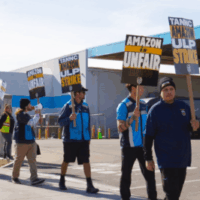NELP opposes the SHIELD Act, not only because it would disqualify striking workers from receiving unemployment insurance (UI), but because the bill’s language is so broad that it would disqualify workers who may never strike, may not be a member of the union that goes on strike, and may not even be in the same state as the workers who go on strike.[i] Any worker who is impacted by a labor dispute could be disqualified under this bill. It would disqualify workers who never strike in retaliation against the 0.17% of workers who exercise their protected right to strike.[ii]
Broad UI Coverage, Including of Workers on Strike, is More Consistent with the Purpose of UI
- The purpose of UI is to protect workers and the economy against the adverse impacts of economic downturns and disruptions to the availability or suitability of work.
- The labor dispute disqualification in many states’ laws and in the SHIELD Act is inconsistent with the general purpose of UI and with other provisions in federal and state laws.[iii]
“Directly Interested” Disqualifies All Workers Impacted by a Labor Dispute
- The SHIELD Act disqualifies workers who are “directly interested” in the labor dispute. This language is copied from many states’ labor dispute laws.[iv] It disqualifies workers who are not involved in the labor dispute.
- Under most states statutory or case law, a worker is “directly interested” if their wages, hours, or working conditions could be impacted by the labor dispute,[v] even if the worker does not participate in, finance, or even work in the same state as the strike.[vi]
- In Massachusetts, the court held, “the prevailing view is that a person is ‘directly interested’ in a dispute when his wages, hours, or conditions of work will be affected favorable or adversely by the outcome. It is of no consequence that the person is not a member of the union conducting the strike or that he may not be in sympathy with its purposes” (emphasis added).[vii]
- Similar conclusions were reached by courts in Arizona,[viii] Colorado,[ix] Connecticut,[x] Georgia,[xi] Indiana,[xii] Louisiana,[xiii] New Jersey,[xiv] Michigan,[xv] Missouri,[xvi] Virginia,[xvii] Pennsylvania,[xviii] and Rhode Island.[xix]
Excludes More Workers than Most States’ Disqualification Laws
- Unlike many states, the SHIELD Act does not limit the disqualification to members of the grade or class of workers who are participating in, directly financing, or directly interested in the dispute.[xx]
- Unlike most states, the SHIELD Act does not set guardrails on the disqualification period, such as limiting it to the period when the dispute is in “active progress”[xxi] or specifying when the labor dispute disqualification period ends.[xxii]
- Unlike many states, the SHIELD Act does not limit the disqualification to labor disputes at the “factory, establishment, or other premises” where the worker was last employed.[xxiii]
Places Further Burdens on State UI Agencies and Courts
- The existing labor dispute disqualification in most states’ laws “has generated a tremendous amount of litigation in its relatively brief history, attesting, perhaps, not only to the great number and variety of factual situations to which it may pertain, but also to a certain confusion among courts and administrative agencies as to its proper purpose and application” (emphasis added).[xxiv]
- By adopting even broader language than most states and by not defining ambiguous terms such as “labor dispute,” “participating in,” “financing,” and “directly interested in,” the SHIELD Act applies none of the learnings from nearly 90 years of state law.
- The SHIELD Act will be even more difficult for state UI agencies to administer than state laws, leading to more improper denials,[xxv] more appeals, and more burdens on the courts.
Disqualifies the Many to Target the Few
- The stated—and deeply misguided—impetus for the SHIELD Act is to “[ensure] individuals who voluntarily go on strike are not eligible to receive unemployment benefits.”[xxvi]
- In 2024, only 293,500—just 0.17% of the labor force—went on strike for any period of time.[xxvii]
- Strikes are generally short; 86% of strikes are less than two weeks.[xxviii]
- Across a nearly three-year period, only 17 strikes in Oregon[xxix] would have qualified for UI under the state’s new law that Rep. Yakym cited as the impetus for the SHIELD Act.[xxx]
May Harm Local Economies
- Workers rely on wages to maintain household spending at businesses and to pay taxes.
- If workers are unemployed and are disqualified from receiving UI under the SHIELD Act, their household spending and tax rates will be reduced, which will have an adverse impact on other businesses, workers, and regional and state economies.
Removing or Reducing the Scope of the Labor Dispute Disqualification Protects Workers and the Economy
- Extending UI to striking workers, as Oregon and Washington State have done, could reduce strikes by encouraging fair negotiations and reducing bad-faith “final offers.”[xxxi]
- Extending UI to striking workers maintains workers’ flow of income, which in turn can help stabilize the economy.
Endnotes
[i] Virginia Employment Commission Decision # 3184-C (Jan. 28, 1958), https://www.vec.virginia.gov/vecportal/unins/precedent/pdf/Labor-Section35/35-3184-C.pdf.
[ii] Iyer, D. K., O’Brien, L., Han, H., and Kallas, J. (2025). Labor Action Tracker: Annual Report 2024. ILR School, Cornell University & LER School, University of Illinois, available at: https://www.ilr.cornell.edu/faculty-and-research/labor-action-tracker-2024.
[iii] As a legal scholar noted in 1955, “[T]he provision has been interpreted in surprisingly broad strokes for an exception to the overall basic purpose of the [UI] statute.” Jerre S. Williams, The Labor Dispute Disqualification – A Primer and Some Problems 8 Vanderbilt Law Review 338, 375 (1955).
[iv] States adopted labor dispute disqualifications in their original UI laws in and around 1937. Milton I. Shadur, Unemployment Benefits and the “Labor Dispute” Disqualification, 17 U of Chicago L Rev 294, 294-295 (1949). For an example of a statute with several provisions that are common amongst states, see Florida’s law (Fla. Stat. Ann. § 443.101 (4), available at: http://www.leg.state.fl.us/statutes/index.cfm?App_mode=Display_Statute&URL=0400-0499/0443/Sections/0443.101.html.
[v] 62 A.L.R. 3d 314 (B) §8.
[vi] Virginia Employment Commission Decision, supra note 1.
[vii] Martineau v. Dir. of Div. of Emp. Sec., 106 N.E.2d 420, 424 (Mass. 1952).
[viii] Brobston v. Emp. Sec. Comm’n, 385 P.2d 239, 243 (Ariz. 1963).
[ix] Burak v American Smelting & Refining Co., 302 P2d 182 (Colo. 1956).
[x] Lanyon v. Adm’r, Unemployment Comp. Act, 89 A.2d 558, 565 (Conn. 1952).
[xi] “It is immaterial that the claimants, whether as members of the union or not, may not have voted for or participated in the strike which caused the stoppage of the work, and may not have been in sympathy with the strike and may have attempted to go back to work but were prevented by the pickets. Since they are directly interested in the dispute which caused the stoppage of the work and their unemployment, they are not entitled to the benefits of the act.” Huiet v. Boyd, 13 S.E.2d 863, 867 (Ga. App. 1941).
[xii] Kemiel v. Rev. Bd., Ind. Emp. Sec. Div., 72 N.E.2d 238 (Ind. App. 1947).
[xiii] Senegal v. Lake Charles Stevedores, Inc., 197 So. 2d 648 (La. 1967).
[xiv] “When a labor dispute which concerns a part of all of the employees causes, as a direct result, a stoppage of work, then the statute says that every employee thereby put out of employment is directly interested unless he belongs to a grade or class of workers other than those directly interested in the dispute.” Gerber v. Bd. of Rev., Div. of Emp. Sec., New Jersey Dep’t of Lab. & Indus., 120 A.2d 436, 439 (1956).
[xv] Nobes v. Michigan Unemployment Comp. Comm’n, 21 N.W.2d 820 (Mich. 1946)
[xvi] Poggemoeller v. Indus. Comm’n, Div. of Emp. Sec., 371 S.W.2d 488 (Mo. App. 1963).
[xvii] Virginia Employment Commission, supra note 1.
[xviii] Lepper v. Unemployment Comp. Bd. of Rev., 146 A.2d 337 (Pa. Super. 1958)
[xix] “It may be argued that this construction [of the labor dispute disqualification provision] is inconsistent with the legislative mandate that [UI] statutes be liberally construed so as to alleviate the economic and social distress that accompanies unemployment even when resulting from strikes and labor disputes. [. . . .] However, we are persuaded from an examination of the language of our statute [. . . ] that the legislators intended not only to penalize those actually members of the involved union but to bar from payments those [. . . . ] employees not members of the involved union who nevertheless have a direct interest in the outcome of the dispute” (emphasis added). Annese v. Bd. of Rev. of Dep’t of Emp. Sec., 249 A.2d 46, 47–48 (R.I. 1969).
[xx] Arizona (A.R.S. § 23-777 (A)), Arkansas (A.C.A. § 11-10-508 (b)), Colorado (CO ST § 8-73-109 (2)), Georgia (Ga. Code Ann. § 34-8-195 (4)(B)), Maine (26 M.R.S.A. § 1193 (4)(B)), and Oklahoma (40 Okl.St.Ann. § 2-410 (2)(b)) do not disqualify workers who are not members of the grade or class of workers that are participating in, financing, or directly interested in the labor dispute.
[xxi] U.S. Dep’t of Labor, Comparison of State Laws 5-21 to 5-23 (2023), https://oui.doleta.gov/unemploy/pdf/uilawcompar/2023/complete.pdf.
[xxii] Id. Many state laws expressly define when the dispute disqualification ends. Id. Arkansas (A.C.A. §11-10-508 (a)), Colorado (C.R.S.A. § 8-73-109(b)), Georgia (Ga. Code Ann. 43-8-194 (4)), Indiana (I.C. 22-4-15-3 (b)), and North Carolina (N.C.G.S.A. § 96-14.8 (b)) end the disqualification after the work stoppage ends and normal operations resume. Michigan (M.C.L.A. 421.29 (8)(a)(i)) and Virginia (Va. Code §60.2-612 (2)(a)) end the disqualification after start-up operations are complete. In some states, the disqualification ends after the worker earns adequate wages in new employment. See M.C.L.A. 421.29 (8)(b); V.A.M.S. 288.040 (6)(1); 26 M.R.S.A. § 1193 (4) (C); M.G.L.A. 151A § 25 (b)(4); N.H. Rev. Stat. § 282-A:36 (III); U.C.A. 1953 § 35A-4-405 (4)(c).
[xxiii] 60 A.L.R.3d 11.
[xxiv] 63 A.L.R.3d 88 § 1.
[xxv] Matthew M. Young, et al. Complexity, errors, and administrative burdens 2847, 2862, Public Management Review (Dec. 21, 2023), https://doi.org/10.1080/14719037.2023.2288247.
[xxvi] See Press Release, Congressman Rudy Yakym, Rep. Yakym Introduces Bill to Protect Unemployment Benefits for Those Truly Without Work (July 16, 2025), https://yakym.house.gov/posts/rep-yakym-introduces-bill-to-protect-unemployment-benefits-for-those-truly-without-work.
[xxvii] Iyer, D. K., O’Brien, L., Han, H., and Kallas, J. (2025). Labor Action Tracker: Annual Report 2024. ILR School, Cornell University & LER School, University of Illinois, available at: https://www.ilr.cornell.edu/faculty-and-research/labor-action-tracker-2024.
[xxviii] Daniel Perez, Unemployment Insurance for Striking Workers: A Low-Cost Policy That’s Good for Workers and State Economies EPI, at 20 (Feb. 3, 2025), https://files.epi.org/uploads/adoc-2025-01-31T114301.481-MCedited.pdf.
[xxix] Id., at 18.
[xxx] See Press Release, Congressman Rudy Yakym, Rep. Yakym Introduces Bill to Protect Unemployment Benefits for Those Truly Without Work (July 16, 2025), https://yakym.house.gov/posts/rep-yakym-introduces-bill-to-protect-unemployment-benefits-for-those-truly-without-work.
[xxxi] Perez, supra note 28, at 13.
Related to
Related Resources
All resourcesNELP’s New York City Worker Justice Agenda

Policy & Data Brief
Why Lawmakers Must Remove the Labor Dispute Disqualification from Unemployment Insurance

Policy & Data Brief
Workers Denied: How to Diagnose and Prevent Improper Unemployment Insurance Denials

Policy & Data Brief
